Related Research Articles

Ammonoids are extinct spiral shelled cephalopods comprising the subclass Ammonoidea. They are more closely related to living coleoids than they are to shelled nautiloids. The earliest ammonoids appeared during the Devonian, with the last species vanishing during or soon after the Cretaceous–Paleogene extinction event. They are often called ammonites, which is most frequently used for members of the order Ammonitida, the only remaining group of ammonoids from the Jurassic up until their extinction.

The Tipulomorpha are an infraorder of Nematocera, containing the crane flies, a very large group, and allied families.

The Bibionomorpha are an infraorder of the suborder Nematocera. One of its constituent families, the Anisopodidae, is the presumed sister taxon to the entire suborder Brachycera. Several of the remaining families in the infraorder are former subfamilies of the Mycetophilidae, which has been recently subdivided. The family Axymyiidae has recently been removed from the Bibionomorpha to its own infraorder Axymyiomorpha.
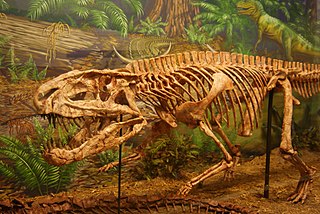
Postosuchus, meaning "Crocodile from Post", is an extinct genus of rauisuchid reptiles comprising two species, P. kirkpatricki and P. alisonae, that lived in what is now North America during the Late Triassic. Postosuchus is a member of the clade Pseudosuchia, the lineage of archosaurs that includes modern crocodilians. Its name refers to Post Quarry, a place in Texas where many fossils of the type species, P. kirkpatricki, were found. It was one of the apex predators of its area during the Triassic, larger than the small dinosaur predators of its time. It was a hunter which probably preyed on large bulky herbivores like dicynodonts and many other creatures smaller than itself.
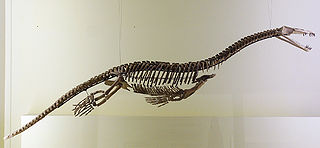
Nothosaurus is an extinct genus of sauropterygian reptile from the Triassic period, approximately 240–210 million years ago, with fossils being distributed throughout the former Tethys Ocean, from North Africa and Europe to China. It is the best known member of the nothosaur order.

Thrinaxodon is an extinct genus of cynodonts, including the species T. liorhinus which lived in what are now South Africa and Antarctica during the Early Triassic. Thrinaxodon lived just after the Permian–Triassic mass extinction event, its survival during the extinction may have been due to its burrowing habits.

Peteinosaurus was a prehistoric genus of pterosaur. It lived in the late Triassic period in the late Norian age, and at a wingspan of around 60 cm (24 in), was one of the smallest and earliest pterosaurs, although other estimates suggest a wingspan of up to 1 m (3.3 ft).
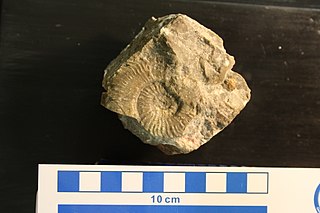
Arpadites is a genus of ceratitids in the family Trachyceratidae from the Middle and Upper Triassic of Nevada, Alps, Italy, Balkans, Himalayas, and Japan.
Bacchites is a genus of extinct ammonoid cephalopods belonging to the ceratitid family Juvavitidae.
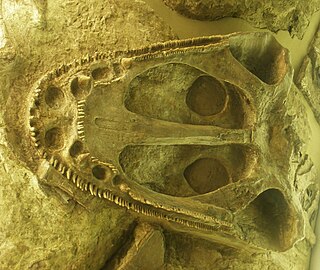
Mastodonsauridae is a family of capitosauroid temnospondyls. Fossils belonging to this family have been found in North America, Greenland, Europe, Asia, and Australia. The family Capitosauridae is synonymous with Mastodonsauridae.
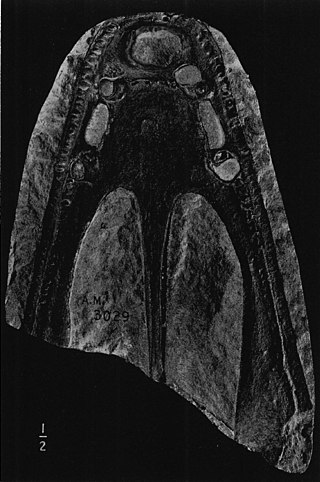
Stanocephalosaurus is an extinct genus of large-sized temnospondyls living through the early to mid Triassic. The etymology of its name most likely came from its long narrow skull when compared to other temnospondyls. Stanocephalosaurus lived an aquatic lifestyle, with some species even living in salt lakes. There are currently three recognized species and another that needs further material to establish its legitimacy. The three known species are Stanocephalosaurus pronus from the Middle Triassic in Tanzania, Stanocephalosaurus amenasensis from the Lower Triassic in Algeria, and Stanocephalosaurus birdi, from the middle Triassic in Arizona. Stanocephalosaurus rajareddyi from the Middle Triassic in central India needs further evidence in order to establish its relationship among other Stanocephalosaurs. Like other temnospondyls, Stanocephalosaurus was an aquatic carnivore. Evidence of multiple species discovered in a wide range of localities proves that Stanocephalosaurus were present all across Pangea throughout the early to mid Triassic.
Coahomasuchus is an extinct genus of aetosaurine aetosaur. Remains of the genus have been found from deposits in Texas and North Carolina that date to the Otischalkian faunachron of the Late Triassic. It was small for an aetosaur, being less than 1.5 metres long. The dorsal plates are distinctively flat and unflexed, and have a faint sub-parallel to radial ornamentation. The genus lacked spines or keels on these plates, features seen in many other aetosaurs. Coahomasuchus was very similar in appearance to the closely related Aetosaurus.
Platycraniellus is an extinct genus of carnivorous cynodonts from the Early Triassic. It is known from the Lystrosaurus Assemblage Zone of the Normandien Formation in South Africa. P. elegans is the only species in this genus based on the holotype specimen from the Ditsong National Museum of Natural History in Pretoria, South Africa. Due to limited fossil records for study, Platycraniellus has only been briefly described a handful of times.
Pseudotemperoceras is an extinct genus of nautiloid cephalopods belonging to the Orthocerida from the far eastern part of the Russian Federation that lived during the Triassic from 249.7 to 245 mya, existing for approximately 4.7 million years.
Syringonautilidae is a family of Nautiloidea from the middle to late Triassic. Syringonautilidae comprise the last of the Trigonoceratoidea and are the source for the Nautilaceae which continued the Nautiloidea through the Mesozoic and into the Cenozoic right down to the recent. Syringonautilidae is a strictly Triassic family, derived early in the Triassic from the Grypoceratidae.
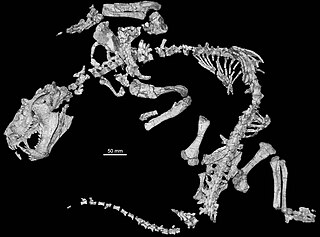
Trucidocynodon is an extinct genus of ecteniniid cynodonts from the Upper Triassic (Carnian) of Brazil. It contains a single species, Trucidocynodon riograndensis. Fossils of Trucidocynodon were discovered in outcrops of the Upper Santa Maria Formation in Paleorrota Geopark, Agudo. Trucidocynodon is one of the most completely known Triassic cynodonts, as its holotype is a nearly complete and fully articulated skeleton.

Uatchitodon is an extinct genus of Late Triassic reptile known only from isolated teeth. Based on the structure of the teeth, Uatchitodon was probably a carnivorous archosauromorph. Folded grooves on the teeth indicate that the animal was likely venomous, with the grooves being channels for salivary venom. The teeth are similar to those of living venomous squamates such as Heloderma and venomous snakes. Uatchitodon is the earliest known venomous reptile.
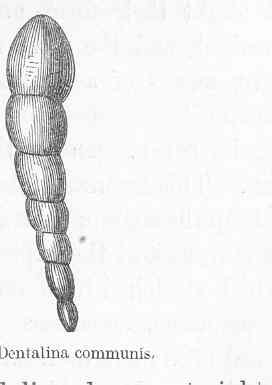
Lagenida is an order of benthic foraminiferal rhizaria in which the tests (shells) are monolamellar, with walls composed of optically and ultra-structurally radiate calcite, with the crystallographic c-axes perpendicular to the surface. Lagenids first appear in the Upper Silurian and continue to the Recent. They are currently divided into two superfamilies, the older Robuloidacea which range from the Upper Silurian to the Lower Cretaceous (Albian) and the younger Nodosariacea, ranging from the Permian to Recent.

Caelestiventus is a pterosaur genus from the Late Triassic found in western North America. The type species, Caelestiventus hanseni, honors Robin Hansen, the Bureau of Land Management geologist (BLM), who facilitated access to the excavation site.
Oryctorhynchus is an extinct genus of rhynchosaur from the Late Triassic (Carnian-Norian)-aged Wolfville Formation of Nova Scotia, Canada that may have been the same animal as Beesiiwo. The type species, O. bairdi, was named and described in 2020. It was originally seen as a species of Hyperodapedon until 2020.
References
- 1 2 Sweet, W.C. 1964. Nautiloidea- Orthocerida. Treatise on Invertebrate Paleontology, Part K. Geol. Soc. of America and Univ Kansas Press
- ↑ Trematoceras -Paleobio db